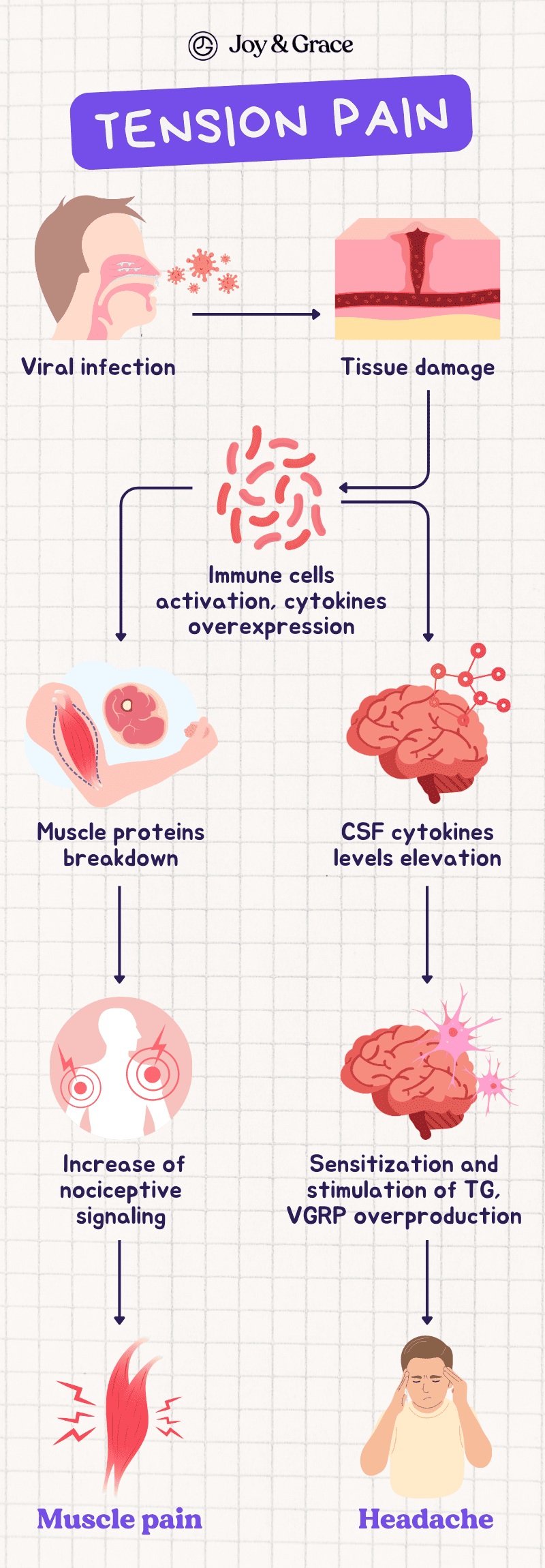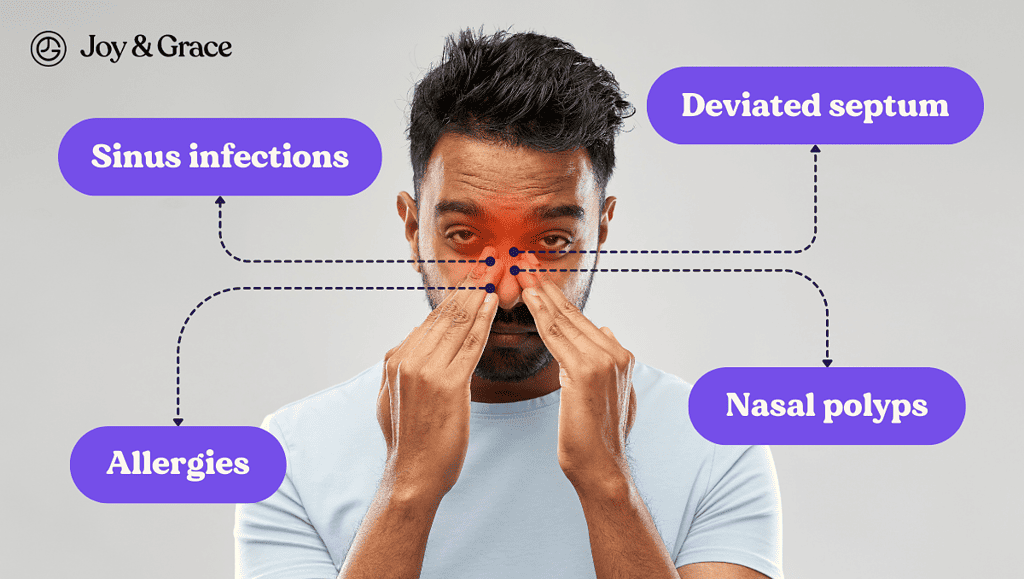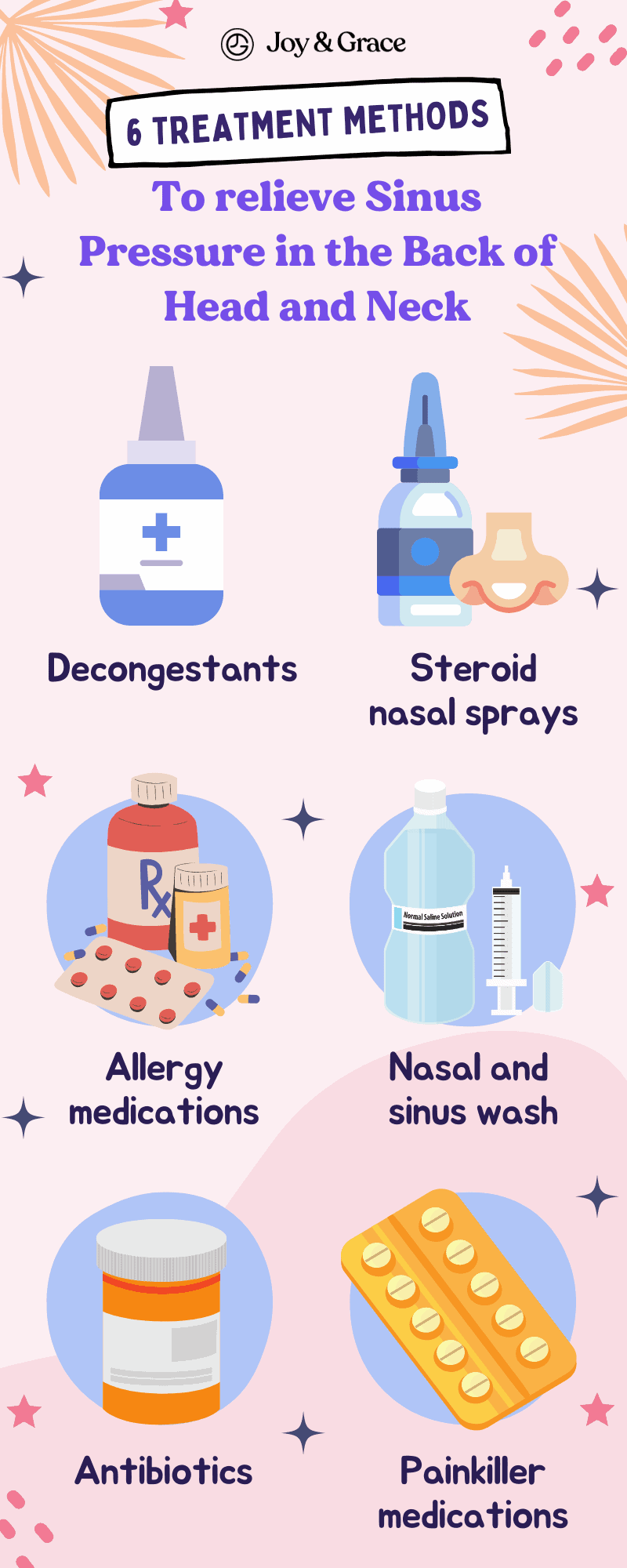Sinus infections are common (and frankly pretty annoying) causes of facial swelling and discomfort. As you are going through a sinus infection, you might notice that you are also feeling neck and shoulder pain. Naturally, you start to wonder if one resulted in the other. In this article, we will be talking about the possible links between sinus infections, neck pain, and shoulder pain. So, let us dive right in!
Can a Sinus Infection Affect My Neck and Shoulder?

So, you are suffering from a sinus infection. But your neck and shoulder also hurt. Is it possible that there is a connection between these conditions? The straightforward answer is yes. Although not a primary symptom, sinus infections can sometimes come along with neck and shoulder pain. Let us explain how this happens.
How Can a Sinus Infection Affect My Neck, Shoulder, and Glands in Neck?

Before we discuss how sinus infections affect the neck and shoulder, let us briefly talk about the anatomy of the paranasal sinuses.
Paranasal sinuses are pocked-filled spaces located in the face area. They are quite important. They make mucus and warm up and humidify the air you breathe before it reaches your lungs. Sinuses also play a big part in speech and lightening the weight of the head. There are four paired types of sinuses:
- Frontal sinuses, located on the forehead area,
- Ethmoid sinuses, located on the upper part of the nose, between the eyes,
- Sphenoid sinus, located deep behind the nose, close to the brain, and
- Maxillary sinuses, in the cheek areas, on both sides of the nose.
A sinus infection is marked by sinusitis. Sinusitis basically means inflammation of the paranasal sinuses. Sinus infections are common, affecting millions of people worldwide.
The inflammation causes your problematic sinuses to produce more mucus than usual. More mucus leads to a stuffy or runny nose, facial pain, and headache.
So, how do sinus infections reach all the way out from the face? Is there a connection between the neck and the sinuses?
There are a few ways sinus infections may indirectly affect your neck, neck glands, and shoulders, causing pain in these areas. We will explain these below.
Sinus Headaches: Can Sinus Headaches Cause Neck and Shoulder Pain?
Studies suggest people with sinus headaches commonly report neck and shoulder pain.
“Sinus headache” is a popular term commonly used to describe a headache originating from a nose and paranasal sinus disorder.
According to a 2019 study, around 84% of patients with sinus headaches also reported associated neck pain. In 75% of cases, neck movements and posture changes (which also involve the shoulders) added to the headache.
More research is needed, however.
The study's authors say:
“We still cannot conclude if the neck and shoulder pain is an incidental feature of sinus headaches, a secondary effect of a sinus headache pain syndrome, or a sign of a mixed headache type. It is also impossible to guess how or if the pain from the neck problem is worsening the sinus headache.”
Still, these percentages indicate a good chance of a connection between sinus infection headaches and neck and shoulder pain.
Tension Pain: Can Sinusitis Cause Muscle Pain and Neck Tension?

As we mentioned, people with sinusitis commonly report also suffering from headaches, neck and shoulder pain, and other annoying symptoms.
The infection that is causing sinusitis may also cause muscle pains, known as myalgia. A study says that as many as half of patients with a respiratory infection also experience myalgia. The mechanism behind this relationship is thought to be the release of cytokines.
Cytokines are substances that promote inflammation in the muscles, thus resulting in pain.
Myalgia and other symptoms can make you feel stressed and tired, even at night. As a result, your muscles may become tense, and you won’t be able to rest and sleep properly. The shoulder and neck muscles are no exception; hence, this chain of events can ultimately lead to neck and shoulder pain.

Thus, we advise you to address your complaints if you suffer from sinusitis. This is the only way for you to receive the right therapy and prevent dangerous consequences.
Mucus Buildup: Can Sinus Drainage or Post-Nasal Drip Cause Neck and Shoulder Pain?
Yes, sinus drainage and postnasal drip may indirectly lead to neck and shoulder pain. When the sinuses are inflamed, they start producing excess mucus. The body tries to clear it by swallowing frequently. Thus, the mucus begins building up in the throat.
Frequent swallowing can result in muscle strain and tension in the neck and shoulder area. Mucus buildup in the throat can also lead to a sore throat and persistent coughing. These add to the pain by damaging the throat lining.
Neck Glands: Can Sinusitis Cause Swollen Lymph Nodes in Neck?

The infection behind the inflammation and pressure on your sinuses can also spread and affect the surrounding structures. And neck lymph nodes are no exception!
Neck lymph nodes or glands are located in groups along the neck.
They are indirectly connected to the sinuses and may swell with a sinus infection. The swelling of lymph nodes is known as lymphadenopathy.
The inflammation can spread to the throat, causing a sore throat (a.k.a. pharyngitis). Pharyngitis may also result in neck pain.
The swollen glands in your neck indicate that your immune system is fighting the infection. They usually return to their normal size once the infection clears.
Rarely, swollen neck lymph nodes or neck glands may be a sign of a more serious underlying condition. So, make sure to have them checked if you notice they have become bigger than usual.
What Does Sinus Neck Pain Feel Like?
The neck pain from sinus infections may have various qualities based on how it arose.
For example, if the pain comes from increased muscle and joint tension, it may feel like discomfort and increased pressure. When lymph nodes are affected, the neck usually feels swollen and congested. Whereas in the case of pharyngitis, neck pain may come on as the burning feeling of a sore throat.
Other Causes of Sinus Inflammation and Neck Pain

So far, we have talked about sinus infections in relation to neck and shoulder pain. But other factors may lead to an inflamed sinus as well.
Here are some of the most common causes of sinusitis:
- Sinus infections (most often due to viral infections such as the common cold, but also bacterial and fungal infections). As we have been discussing, infections are the most common causes of sinus inflammation or sinusitis.
- Allergies. Allergies can cause inflammation in the sinuses, leading to pain in the face and neck. Allergy symptoms such as congestion and sinus pressure can also cause tension in the neck, leading to pain. Common allergens and irritants include animal dander, polluted air, smoke, and dust.
- Deviated septum. A deviated nasal septum is a condition where the wall that separates the two nostrils is off-center. This can block the sinuses, leading to pain in the face, head, and neck.
- Nasal polyps. Nasal polyps are growths in the nasal passages that can block the sinuses and cause nasal obstruction. They can cause pain and pressure in the face and neck. Polyps are often associated with chronic sinusitis.
By causing sinusitis, all of these factors may indirectly affect the neck and shoulder.
You should know that just because you have neck and shoulder pain does not always mean you have sinusitis. Neck pain and shoulder pain can have numerous causes, such as:
Can Nerve Damage Cause Sinus Problems and Neck Pain?
There are a few special nerves called cranial nerves. They are mostly responsible for functions of the head and neck structures.
Three cranial mediate the functions of paranasal sinuses. If these nerves are damaged, sinus problems may arise. An interesting way these nerves can get damaged is from neck problems.
How the tables have turned!
Unstable neck vertebrae or herniated discs may pinch the nerves and interfere with the impulses they carry. As a result, sinusitis may appear.
The cranial nerves that supply the sinuses include the following:
- Ophthalmic nerve. Damage or dysfunction of this nerve can affect sinus function and vision. Sinusitis may appear as there are no signals for proper drainage of sinuses. Vision becomes worse, and pupil dilation may occur as well. Pupil dilation is a sign of cervical instability that can cause sinusitis. So, this is one way a neck disorder can lead to sinusitis.
- Maxillary nerve. The maxillary nerve supplies, among others, parts of the nasal cavity, mouth, and sinuses. Thus, problems in the roof of the mouth may also lead to sinus congestion and sinusitis.
- Vagus nerve. The vagus nerve supplies the sinuses, the back of the throat, and the larynx (and many other structures). If it experiences damage, you might expect sinus problems, which may lead to neck and shoulder pain.
Changes in cranial nerve function may also be caused by conditions other than neck problems. These conditions include the following:
- Poorly controlled diabetes,
- High blood pressure,
- Head injuries,
- Infections,
- Strokes, and
- Brain tumors.
What Are the Symptoms of Sinusitis?

The most common characteristic symptoms that indicate sinus inflammation include the following:
- Green or yellow discharge from the nose,
- Blocked nose,
- Pain and tenderness around the cheeks, eyes, and forehead,
- Sinus headache,
- Fever (100.4F or 38C or more),
- Toothache,
- Reduced sense of smell,
- Bad breath (halitosis).
The diagnosis of sinus inflammation is usually “clinical.” This means that your doctor will mainly diagnose sinusitis based on clinical signs and symptoms. Other tests that can be used include the following:
We can also classify sinusitis depending on how long the symptoms we mentioned last. Thus, we have the following sinusitis types:
- Acute sinusitis: Starts suddenly and lasts less than four weeks with complete resolution.
- Subacute sinusitis: Symptoms last for 4-12 weeks.
- Recurrent acute sinusitis: Four or more episodes of acute sinusitis, lasting at least seven days each, in a 1-year period.
- Chronic sinusitis: Signs of symptoms persist for 12 weeks or longer.
What Happens if a Sinus Infection Spreads to the Brain?
If left untreated, a sinus infection can cause severe, life-threatening complications, such as:
- Meningitis. If a sinus infection spreads to the brain, it can cause meningitis. Meningitis is an inflammation of the membranes that surround the brain and spinal cord. This inflammation can lead to severe headaches, fever, and a stiff neck. In some cases, it can even cause seizures, coma, or death. Meningitis is a serious medical condition that requires immediate attention.
- Abscesses. An abscess is another potential complication of a sinus infection that spreads to the brain. This is a collection of pus that forms in the brain tissue. A brain abscess causes severe headaches, fever, seizures, weakness, or paralysis of one side of the body. It also leads to changes in mental status, such as confusion or disorientation.
People with a weakened immune system are at an increased risk of developing a severe sinus infection that can spread. These include those suffering from HIV/AIDS, cancer, or diabetes.
If you suspect your sinus infection has spread, seek medical care immediately.
How Do I Relieve Sinus Pressure in the Back of My Head and Neck?
What is the best way to get rid of sinusitis symptoms, including neck and shoulder pain? The answer depends on the underlying cause.
When you have pressure in your sinuses, it can be difficult to focus on anything else. Several ways exist to relieve sinus pressure and get some much-needed relief.
A warm compress is one of the most effective ways to relieve sinus pressure. Place a warm washcloth over your sinuses for about 10 minutes. The warmth will help to reduce inflammation and ease the pressure.
Another way to relieve sinus pressure is to use steam therapy. This can be done by taking a warm shower or using a steam inhaler. The steam can help open up your sinuses and make breathing easier.

However, you should see a doctor immediately if your sinusitis symptoms worsen and last a long time. Your doctor may advise you to use various treatment methods, such as:
- Decongestants, which are used against nasal congestion
- Steroid nasal sprays (nasal corticosteroids), which decrease nasal mucosal swelling
- Allergy medications, such as antihistamine medications
- Nasal and sinus wash or irrigation
- Antibiotics, which should only come into play if an infection is present
- Painkiller medications, such as Tylenol or Ibuprofen
What Helps Neck and Shoulder Pain from Sinus Infections?
The first-line therapy for sinus infections includes the methods that we mentioned above. Nasal irrigation, sprays, decongestants, and allergy meds are widely used. Antibiotics are used only if a bacterial infection is present.
Your doctor might prescribe painkillers and muscle relaxants to ease neck and shoulder pain. Massage therapy and acupuncture have also proved effective in relieving pain. These methods focus on relaxing the painful, tight areas in the muscles from which the pain can spread.
Keep in mind that you should consult your doctor about your symptoms. The treatment plan your doctor devises will help you improve your symptoms, reduce stress, and rest properly again.
Takeaway
Sinus infections can be associated with neck and shoulder pain.
There are four paired types of sinuses:
- Frontal sinuses
- Ethmoid sinuses
- Sphenoid sinuses
- Maxillary sinuses
A sinus infection is marked by sinus inflammation, known as sinusitis. The inflammation causes your problematic sinuses to produce more mucus than usual.
Sinus infections may lead to neck and shoulder pain by any of the following mechanisms:
- By causing sinus headaches that spread
- By causing muscle tension and discomfort
- By causing mucus buildup in the throat
- By causing neck lymph node swelling
Sinus problems and a sore neck may occur together when there is cranial nerve damage.
To get rid of sinusitis, neck pain, and shoulder pain, healthcare professionals may recommend you use the following treatment methods:
- Decongestants, steroid nasal sprays, and nasal irrigation
- Allergy medications
- Antibiotics
- Painkillers and muscle relaxants
- Massage or acupuncture therapy
If left untreated, sinusitis can lead to dangerous complications.















